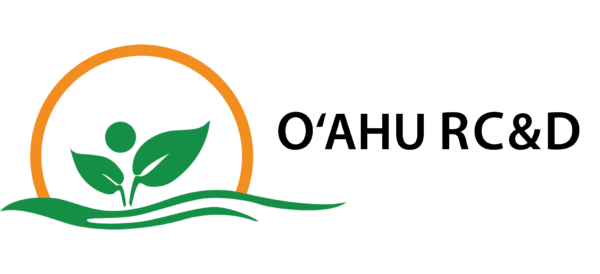Establishing & Maintaining Perennial Peanut on a 20 acre Orchard
Hewitt Farms
Operation Background:
Hewitt Farms is a tropical fruit orchard, demonstrating agroforestry design, on a 20 acre parcel located in Hilo on Andisol order, Hilo series soil. The Hilo series consists of deep, well drained soils that formed in material weathered from volcanic ash. They occur on slopes of 0 to 35 percent. The mean annual rainfall is about 145 inches and the mean annual temperature is 72 degrees F or higher. In general, these soils have large organic components, a high water-holding capacity, P-retention, and a low bulk density. However, in Andisols, calcium, magnesium, potassium, and sodium levels vary as we go from the dry zone to the wet. The dry zone is characterized by an abundance of nutrients, but in the high rainfall areas nutrient levels reach near undetectable levels. For instance, the less weathered Kula series on Maui is quite productive, while the Hilo series on the Big Island are highly weathered and may require lots of fertilizer additions for crop production1. A low base saturation is standard for soils in the Hilo series (USDA). Despite having a low TCEC and challenges in retaining nutrients, members of the Hilo series still constitute some of the best agriculture lands and have historically been used for sugarcane crops. With the decline of the sugar industry, there has been a shift toward truck crops, such as ginger and taro; orchard crops, such as macadamia and papaya; agroforestry and forestry.2
The farm has been under the current management for the past three years and was historically farmed intensively in sweet potato and sugar cane. The main objective of the producer is to establish and maintain a perennial ground cover with an appropriate nitrogen-fixing plant as a priority practice for rapidly improving the soil organic matter (SOM) levels, nutrient cycling and soil aggregate structure. Prior to adopting this practice, the producer reviewed local research, including [add studies from CTAHR]. Local trials with perennial peanut varieties3, such as those conducted with Rusty’s Coffee Farm were encouraging, showing rapid increases in SOM and Total Organic Carbon (TOC).
The labor costs associated with establishing the perennial peanut are high and can take up to a year to fully establish. However, the producer feels this is a worthwhile investment in an orchard setting, as the labor costs for weeding will be greatly reduced over the years. Although the contributions of organic nitrogen, increases in SOM and soil biology habitat are challenging to calculate accurately, the Rusty’s Coffee study provides a good framework for measuring improvements in terms of increased TOC levels. Total Organic Carbon (TOC) is an indicator that can be readily measured by commercial labs and has a direct relationship with SOM4. It is also a ‘master’ indicator for many of the other soil health indicators.5
In addition to establishing perennial peanut as a ground cover, secondary practices used during the land prep phase for expanding the orchard is the use of nitrogen-fixing pioneer plants such as Ice Cream Bean and Pigeon Pea seeded directly in the field. The producer used this practice during the first three years to prep the land prior to installing his orchards.
Project Area:
- The peanut is well established in an existing orchard area, which is setup for trialing Moraceael varieties to identify the best commercial tropical fruit tree crops.
- Peanut is currently being established in an area which is being prepped for an expanded orchard.
- Establishment of perennial peanut using this installation and maintenance design will be applied on an additional 20 acres which is adjacent to the current farm.)


New area adjacent to the Moraceael varietal trial orchard which is slated for perennial peanut 
Example of using weed cloth to terminate the existing grass and prep the area for planting the plugs of perennial peanut 
Field observation of the residue break down under the weed matt 
Example of newly planted perennial peanut plugs with heavy mulch used as weed control during the establishment phase.

Newly planted perennial peanut at 1’x1’ spacing. 
Demonstration of perennial peanut established in the adjacent area after a year of maintenance.
Overview of Steps for Successfully Establishing Perennial Peanut as a Ground Cover in an Orchard System
Land Prep:
- Mow/weed wack (more land prep may be needed if the field has been fallow and box scraper may be needed).
- Lay weed matt to kill off existing ground cover.
- ~ 6 months
Installation:
- Order & prep materials (including pick-up of compost, mulch, biodegradable paper/cardboard, and collection of propagation material);
- *Propagation material must be collected and planted within 24 hours (unless establishing a root first, in which case 1 to 2 weeks in water may be needed).
- Plant plugs and spread material;
- Cover with mulch;
- (Apply irrigation if needed to establish).
- ~ 6-8 hrs.
Maintenance:
- Weed monthly
- After fully established, very low maintenance other than pulling back ground cover from newly planted tree crops.
- ~ 1 yr
Irrigation Cost (if applicable)– Producer does not need to irrigate. This design will need irrigation in more arid regions, especially during the establishment phase and through dry seasons.
Source List & Costs- Source for materials (cover crop seeds, transplant materials, compost, etc.) and cost per unit. Specify planting/application rate.
- Weed matt (12’ wide rolls) and pins. @ 8 cents per sq.ft. $288 (pins @ $90 per box)
- Perennial peanut slips, 5” long and including several nodes – not used yet
- cost/unit_____ (mainly labor as the clippings are collected on site and not paid for)
- Mulch – free. They get it from the county commercial farmer pick-up days (mainly labor). Est. for commercial mulch: 4 cu yds at 4” deep. Mulch is free for this producers, but could cost $48 from Soil Plus on Hawaii Island to $100 from Kona Mulch (average cost ~75 cu yd). *On O’ahu, tree trimmers can provide ~ 3 to 5 cu yds for $50.
- Compost- (optional and based on farm needs). May reduce labor cost for planting plugs. 11 cu yds at 1” deep. X $100 cu yd. = $1,100. *On O’ahu, compost is ~$40 cu yd. On Hawai’i Island cost range from $80 to $120 cu yd.
- Box scraper (if applicable)
- Skid Steer Fuel – fill the tank every 3 months, all that fuel is dedicated to this compost system.
Estimated Costs to Establish & Maintain Perennial Peanut as an Orchard Groundcover6 (per acre)
Land Prep
| Labor activity* | # hours (non-mechanical) | # hours (mechanical) | # people | $ per person | Total costs |
| Mow/weed wack | 2 | N/A | 1 | 15 | $30 |
| Box Scraper (if applicable) | N/A | 3 | 1 | 55 | $165 |
| Lay weed cloth | 6 | N/A | 2 | 15 | $180 |
| Weed for ~ 6 months (while plant material under weed mat dies off) | 8 | N/A | 2 | 15 | $240 |
| Total Land Prep Costs | $615 |
Installation
| Labor activity* | # hours (non-mechanical) | # hours (mechanical) | # people | $ per person | Total costs |
| Collect propagation material | 4 | N/A | 6 | 15 | $360 |
| Pick-up/load mulch | 3 | ? | 1 | 15 | $45 |
| Remove weed cloth | 4 | N/A | 2 | 15 | $120 |
| Prep ground as needed for planting (may require light tilling?) | ? | ? | ? | ? | ? |
| Plant perennial peanut plugs (1’x1’ spacing) | 6 | N/A | 6 | 15 | $540 |
| Spread compost (mechanical) | N/A | 2 | 1 | 55 | $110 |
| Spread compost (non-mechanical) | 4 | N/A | 4 | 15 | $240 |
| Cut/place builders paper or other biodegradable weed control paper (if applicable) (sheet mulching may be needed in some areas) | ? | ? | ? | ? | ? |
| Spread mulch (mechanical) | N/A | 4 | 1 | 55 | $220 |
| Spread mulch (non-mechanical) | 6 | N/A | 6 | 15 | $540 |
| Install irrigation (if applicable) | ? | ? | ? | ? | ? |
| Total Installation Costs (mechanical) | $1,395 | ||||
| Total Installation Costs (non-mechanical) | $1,845 |
Maintenance
| Labor activity* | # hours (non-mechanical) | # hours (mechanical) | # people | $ per person | Total costs |
| Weed (up to 1 year) | 10 hrs monthly | N/A | 4 | 15 | $600 |
| Pull-back ground cover matt away from newly planted tree crops for up to 1 year (to prevent “nitrogen-robbing”) | 2 hrs monthly | N/A | 4 | 15 | $120 |
| Total Maintenance Costs | $720 |
Total Costs
$2,730 (mechanical) – $3,180 (non-mechanical)
- RX for Soils and Crops, CTAHR https://www.ctahr.hawaii.edu/tpss/research_extension/rxsoil/soilsample.htm
- Soil Nutrient Management for Maui County, CTAHR https://www.ctahr.hawaii.edu/mauisoil/b_andisol.aspx
- Two popular cultivars are ‘Golden Glory’ which is a popular landscape ground cover in Hawai`i and ‘Amarillo’ which was developed in Australia for forage and cover crop uses (Hensley). CIAT accessions are used primarily as pasture legumes. Several peanut cultivars are being grown at the Mealani Experiment station on the Big Island (Fukumoto and Yamasaki).
- Organic matter (%) = Total organic carbon (%) x 1.72 to 2.2, so an average of 2 is used by professional agronomist in Hawaii. (This conversion factor assumes organic matter contains 58 % organic carbon. However this can vary with the type of organic matter, soil type and soil depth. Conversion factors can be as high as 2.50, especially for subsoils). Total Organic Carbon (TOC) is recommended as Total carbon (TC) on a soil with alkaline pH results in over reporting the % carbon because the C from carbonate (CO3) will be picked by the analyzer. Total organic carbon (TOC) uses an acid treated to drive off (fizz off as CO2) the carbon from carbonate in the soil before running the sample through the C analyzer. Sometimes the difference between TC and TOC is significant (0.5-1%)
- There is also a local precedent set with the Rusty’s Coffee Plantation study, successfully measuring improvements in Soil Organic Matter (OM) by 1 % after three years of installing a perennial ground cover of perennial peanut. Although this report is not published, it can likely be obtained upon request from HDOA or the United Ka’u Farmers Cooperative, as it was funded through a 2019 Specialty Crop Grant.
- Estimated area: 1 acre orchard with 30 in-row and 30 between-row spacing with grassed alleyways. Estimated sq. ft. of tree rows = 900 linear ft. x 4’ wide rows = 3,600 sq. ft.
Note: As part of Oʻahu Resource Conservation and Development Council’s Soil Health Training Cohort, we are proud to feature some of the innovative practices local farmers are using to regenerate and restore soil health and on-farm ecological services. To learn more about this initiative, please visit our website.
This material is based upon work supported by the U.S. Department of Agriculture, under agreement number NR2192510002C002. Any opinions, findings, conclusions, or recommendations expressed in this publication are those of the author(s) and do not necessarily reflect the views of the U.S. Department of Agriculture. In addition, any reference to specific brands or types of products or services does not constitute or imply an endorsement by the U.S. Department of Agriculture for those products or services.
Resources and References:
- Radovich et al. 2009.
Benefits and Costs of Using Perennial Peanut as Living Mulch for Fruit Trees in Hawaii - Radovich, Pant, Ahmad, Elevitch, Hue. 2014.
Enhancing Soil Function and Plant Health with Locally Available Resources. Available for download at: agroforestry.org







